Last Saturday night, we returned to Chicago after a week traveling through southeast Ireland. Since my last international trip (to London in 2015), so much has changed about the way I capture images, especially the technology I take with me and my strategy and approach to photography while traveling. I could write (and have already written) thousands of words journaling last week’s experience traveling through Ireland. While those stories are the heart of the experience, they’re broad, varied, and complex enough that I haven’t fully had time to process them yet. Fortunately The All Worlds Traveller is a blog about pictures, so I’ll focus on the photography aspect of the trip.

To iPhone or to SLR
In the past, friends have asked my advice about getting a digital SLR (or mirrorless camera). The better the phone cameras have become, the less I’ve encouraged them to get an SLR. I think it depends on how much time you want to spend at the computer editing your images. If the answer is, “A lot of time,” get an SLR or mirrorless camera and welcome to the club.
If sitting for hours playing with sliders, curves, and layers isn’t how you hoped to spend a significant portion of your life, good news: the iPhone Pro (and comparable mobile devices—last year, I upgraded from an 8 to a 13) have pretty much got you covered with a device that can fit in your pocket and fulfill a vast number of other functions. Also, if you don’t see yourself lugging around a camera bag full of bulky and expensive equipment, the SLR might not be your thing.
So if the iPhone Pro models are so good, why shoot with a digital SLR at all?
My answer is that if you know what you want from a digital SLR, it has significantly greater potential as a creative tool. The image sensor and lens options on a full frame digital SLR offer worlds of possibilities, many of which would be difficult to achieve on a phone camera at this time.
On this trip, I wanted to capture stock images of castles that I could use in Distant Era work. So I used the SLR in those instances and didn’t bother with it when I was out and about, where the trio of iPhone 13 Pro lenses (not to mention its capability to shoot in RAW mode in a pinch) made it an invaluable companion for capturing the experience of the trip.
Digital SLR
There’s not too much point in setting a digital SLR to automatic. That’s what the phone camera is for, and it doesn’t know what you want—it only knows what its light sensor perceives.
To capture big environments for the stock images I hoped to get on this trip, I shot with a Canon EF 16–35mm f/2.8L USM lens attached to my loyal EOS 5D Mark IV camera body. Shooting in Manual mode, I usually kept my aperture around f/11, my ISO at 100, and my focal length at 16mm so as to capture the widest view possible.
Reading Histograms
Your camera’s (or phone’s) light meter will give you a reading based on what it’s pointing at, and since the sky is typically brighter than that object (a castle wall, for instance), the camera exposes for the castle wall and blows out the sky. The recent mobile phone cameras have great dynamic range and do a good job compensating for this.
To make sure I captured all the information in the skies, I’d point my camera at the sky and meter based on that. Then I’d make my adjustments. Most of the time, the result was too dark to see on the back of my camera, so I’d set the display to show the histogram. This little graph shows me a light readout of the photograph, and if any of the graph goes beyond the left (shadow) or right (highlight) side, it means information is potentially lost and unrecoverable. If there’s even a small gap between the edge of the wave of information on histogram and its border, you’re in the safe zone and can manipulate those areas in post processing.
Histograms at Cahir Castle
The photographs below show the outside of Cahir Castle, a shooting location for two of my all time favorite films, Excalibur and The Green Knight. In the first picture below, you can see the dark image of the castle and its histogram. The blue splotches on the screen are minor places where the shadows are potentially clipped. The second picture’s histogram shows my edited version, where even those potentially clipped dark areas were recovered. Most important, those bright, cloudy skies weren’t blown out, so we can see the full detail in those beautiful clouds above the castle.
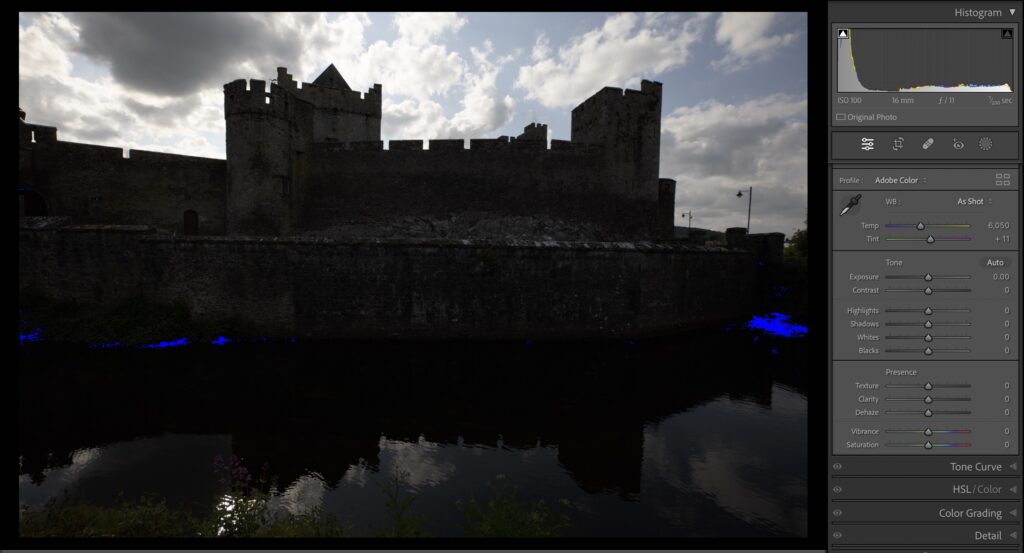
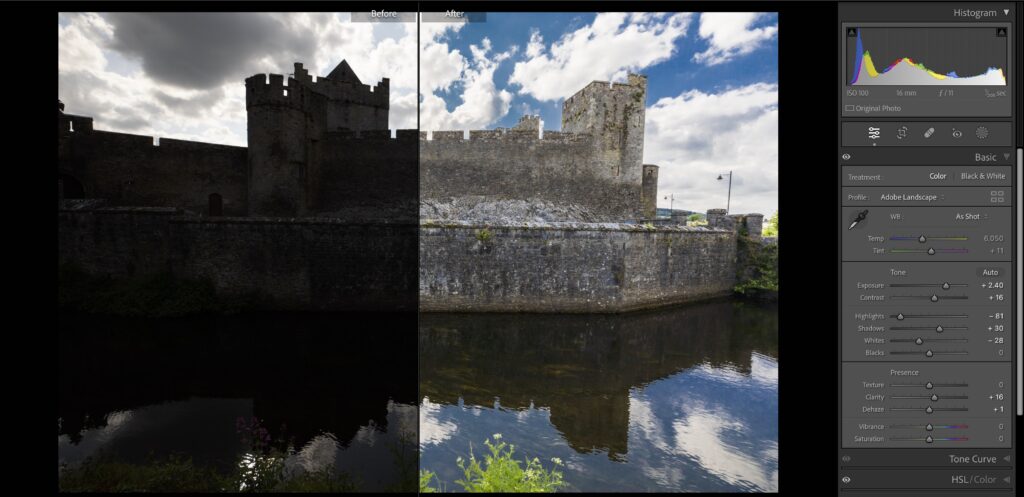

Top right: Before/after edit, showing final histogram.
Bottom: Final edit.
Thus was my strategy for photographing stock images under bright skies in Ireland. As a result, I captured a good number of old walls and towers with well-exposed skies. Even photographing Dunbrody Abbey at sunset and from far away (for which I put on my 24–70mm zoom lens and set the camera on a timer with a five second exposure) I could capture details that ordinarily would have been impossible with a handheld mobile phone.
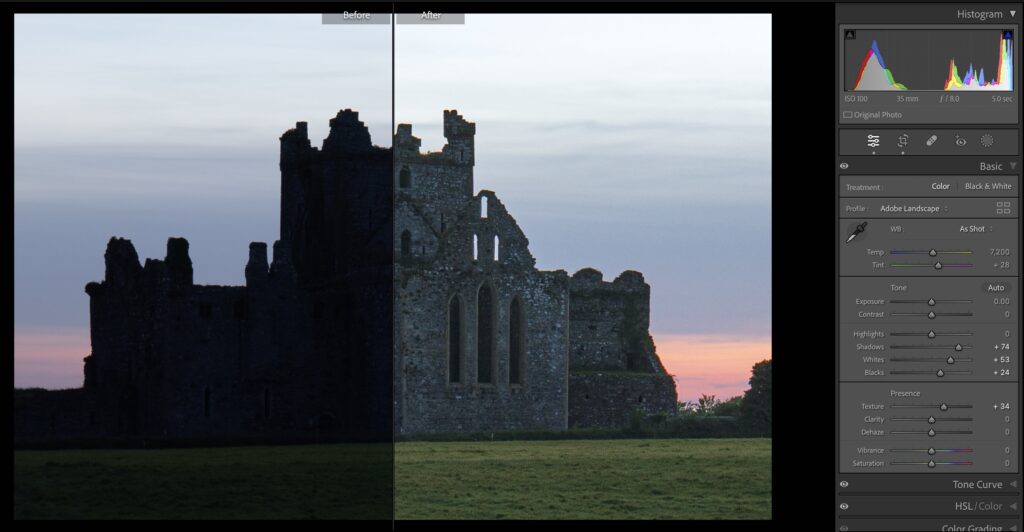
Adding Flash
Once I was terrified of flash, and I hated it, and now it’s my favorite aspect of photography. I love shooting with flash so much that I couldn’t resist packing a single flash and a flash trigger, just in case.
I also added a portable MagnetMod MagSphere and MagGrid to my bag to modify the flash. These came in handy in a few places where Elizabeth brought a dress along.
On the right, you can see an iPhone capture of Elizabeth and her dress from an arch at Cahir Castle. As you can see, it’s a bright day. Compare that to the two images below, shot at the same time in the same location, this time using a flash graciously held by our traveling companion Jon.
These images were shot quickly and without much precision and edited just the same in Lightroom, without the layers of polish I might add in Photoshop. And yet, for “touristing through the castle,” they work just fine, adding specific lighting to the scene and giving it a hint of drama. By comparison, the iPhone shot is a “capture” whereas the lighting and color in the digital SLR images below conjures a mood and character and suggests a time of night (above) or day (below).
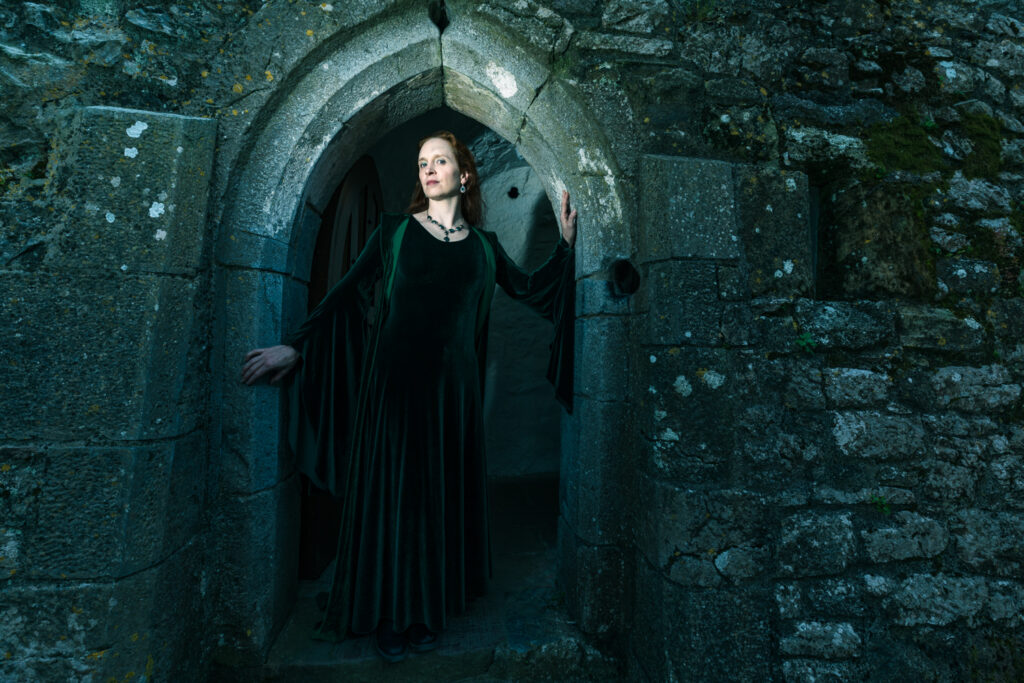
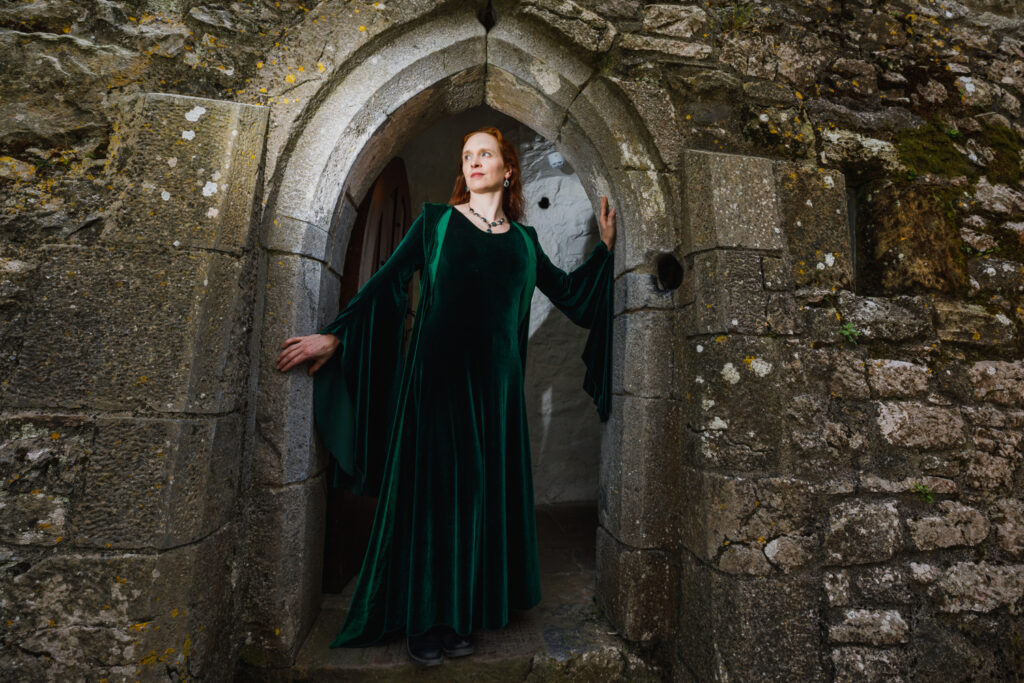
In any case, these are the applications for which I used the digital SLR throughout the trip. I certainly did get a good number of images of old walls and towers, which I hope will appear in future Distant Era work. Now on to the occasions where I left the camera behind.
Mobile Photography
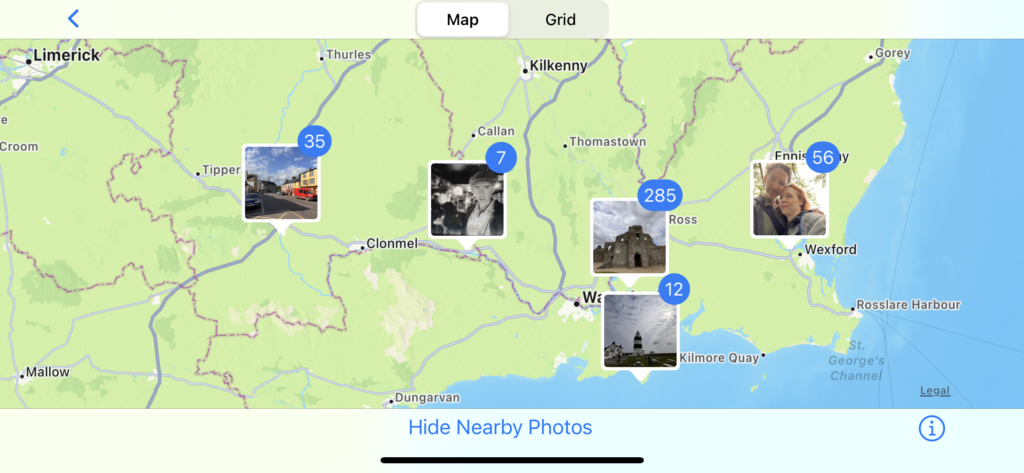
I haven’t been a great mobile photographer in the past, and I’m hopeless at keeping up with Instagram. In late 2021, I upgraded my old iPhone 8 to a 13 Pro in the interest of doing a little better, though my camera roll is mostly pictures of coffee and the same two cats. But I am getting better.
Thanks to the capabilities of the triple lenses on the phone, I can zoom in or go wide; I can take photos with high dynamic range, take macro photos showing intricate detail, or record video. My friend (photographer) Greg Inda likes to say that we carry in our pockets a better camera than Ansel Adams ever had.




The images above are a good example of the kind of experience collecting our phones are capable of doing. Look at that cool, ivy-covered tower we encountered driving through the country. And those big old walls of Dunbrody Abbey. That little bumblebee we happened upon. The tall ship at New Ross where we learned about the Irish who emigrated to America.
Gettin’ Themey
Most of the time when I travel, though, I find myself drawn to photo apps that give me a different perspective on what I’m looking at without having to lift a finger to edit it. I spend all the hours of my day processing pictures, so I enjoy apps that do the job for you. In London in 2015, I loved the Jixipix painting apps for mobile that transformed my London experience into watercolor. In Ireland, it was Hipstamatic’s apps that suited my point of view. This is all kind of on theme for Distant Era, being a photography beyond the here and now.

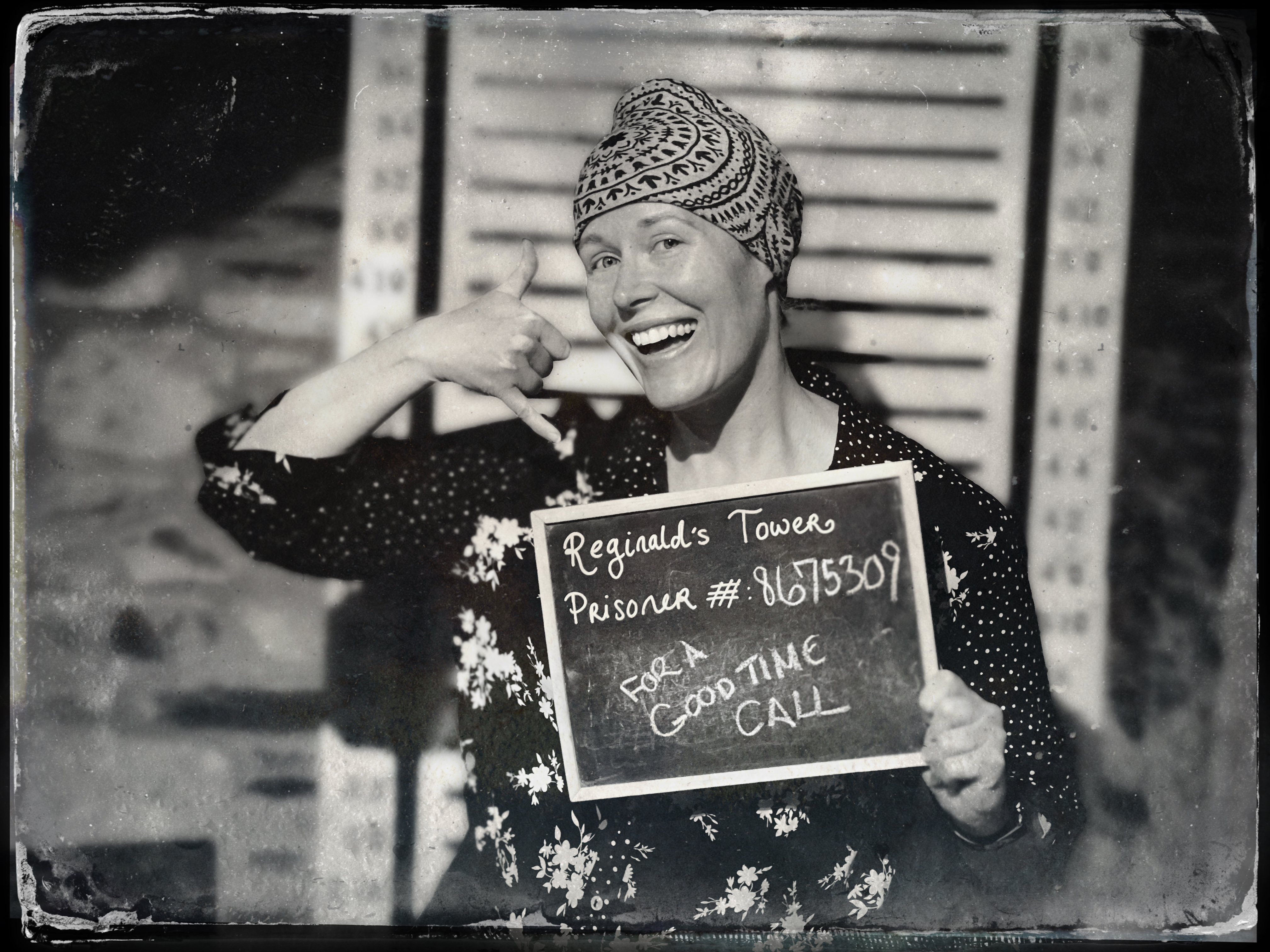
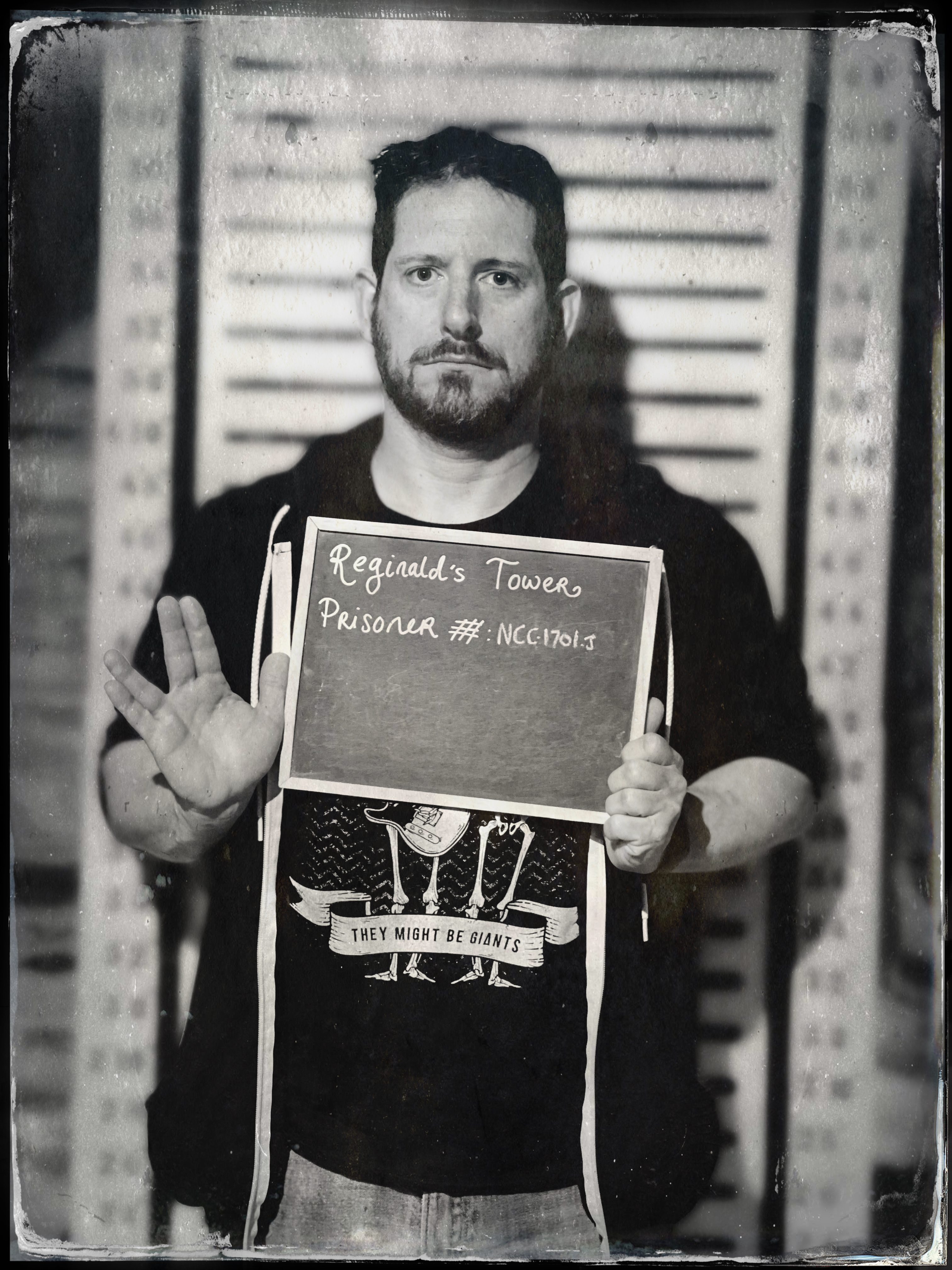

The Hat, Vices
Day one in Ireland, after Cahir Castle, we wandered into a souvenir shop where I found a tweed hat that suited me. It was similar to one I’d worn onstage in Love’s Labor’s Lost at American Players Theater in 2002. I’m not much of a hat guy, but there was something about it. That hat became my identity for my Ireland stay.

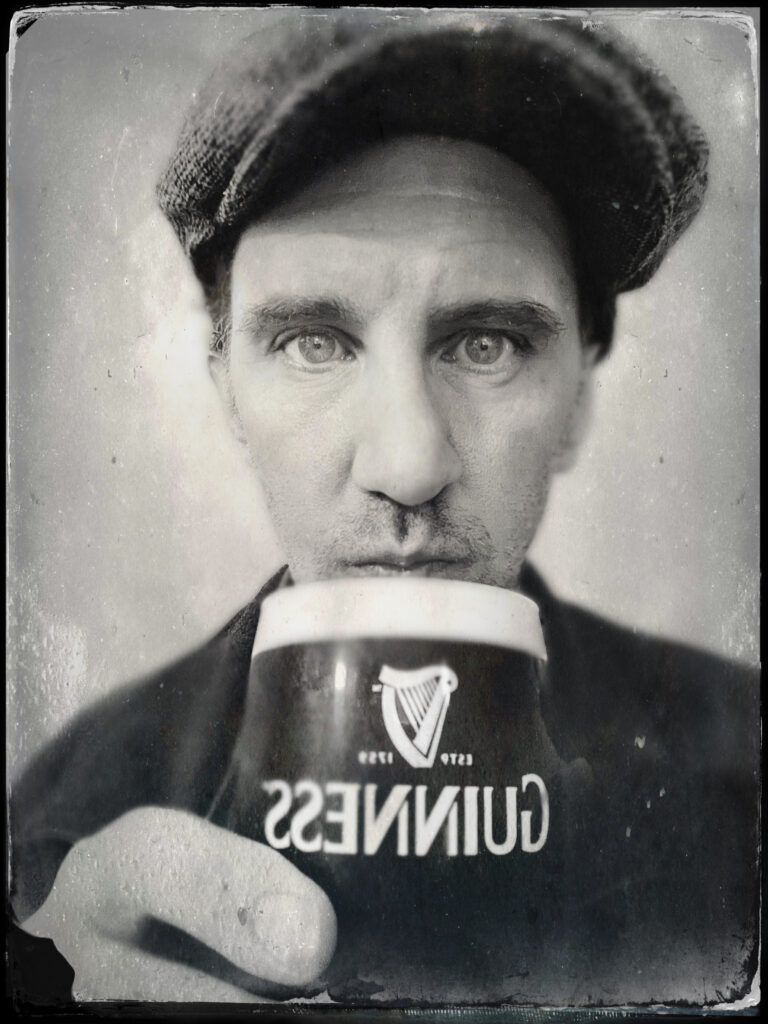
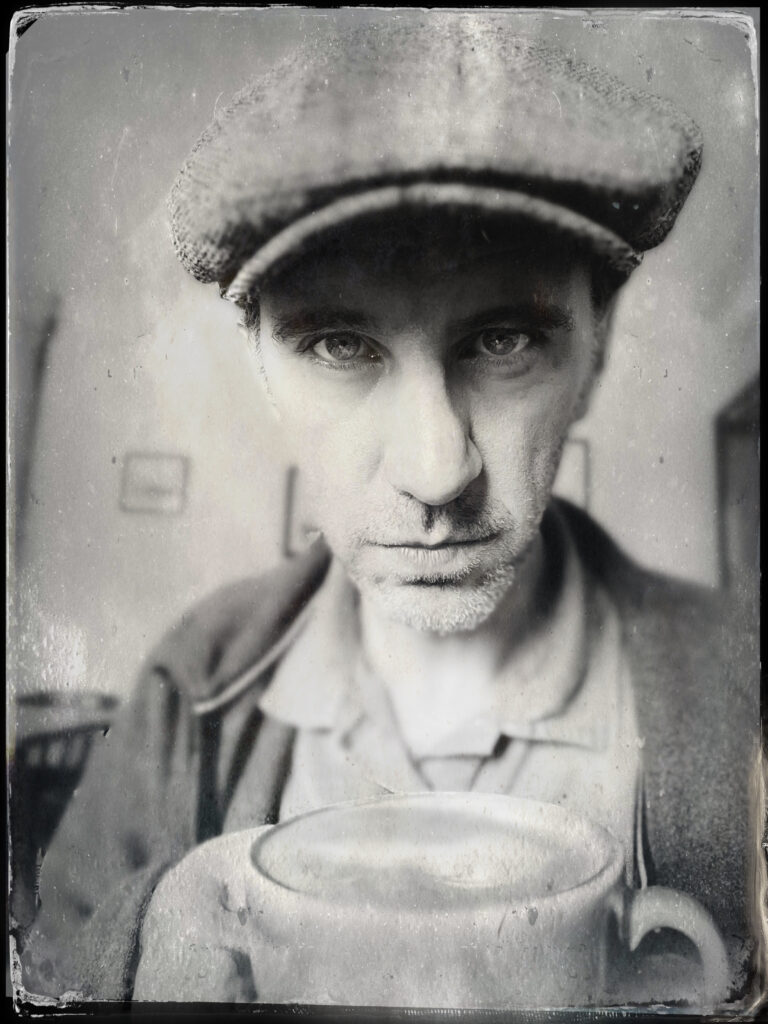
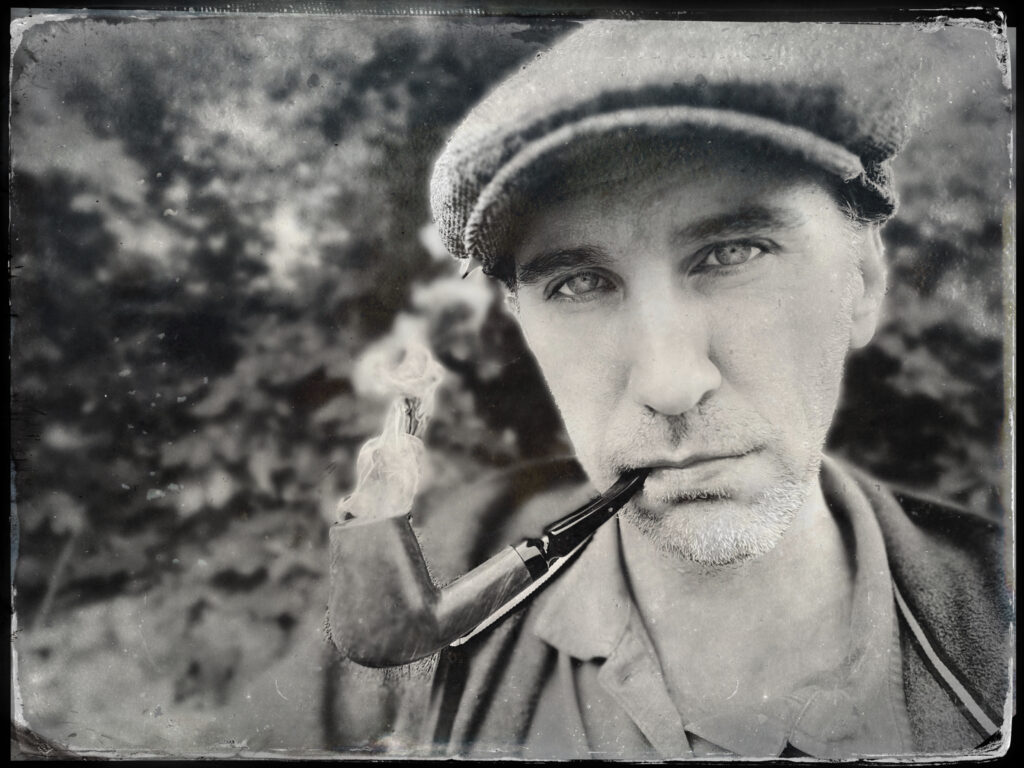
What Is Best
What was best about Ireland wasn’t in the pictures but in the people we met everywhere we went, especially the family of musicians that adopted us for two nights and invited us into their music—Shelly, Margaret, Joe, and their extended family. Sure I have pictures of that, but they don’t convey the sublime warmth and comfort and rightness of a pub by the water late one night, filled with music and stories on the other side of the world.
Or the old man who stopped us on the street in Cahir to tell us jokes, and at the end he said, “Take care… but don’t take Cahir; leave Cahir here.”
Or John the storyteller at Hook Lighthouse, who told old tales of William Marshal and Strongbow and Aoife with such animation, passion, and humor that I could’ve watched and listened to him forever.
Some of these things I captured, but the photograph can only hold their essence, a bookmark and placeholder for the memory.
I came away from Ireland with those memories, with pictures and inspiration, with days of stories and experiences I haven’t even touched on here, and yes, I came away with some stock for Distant Era projects too.
I also came away with a giant blog post that says very little. And yet, distinguishing when and where to use the SLR (for art) vs. the phone camera (for collection and for fun) is useful too, and recognizing where those spaces exist and when I’m doing one vs. the other was good to put in practice.

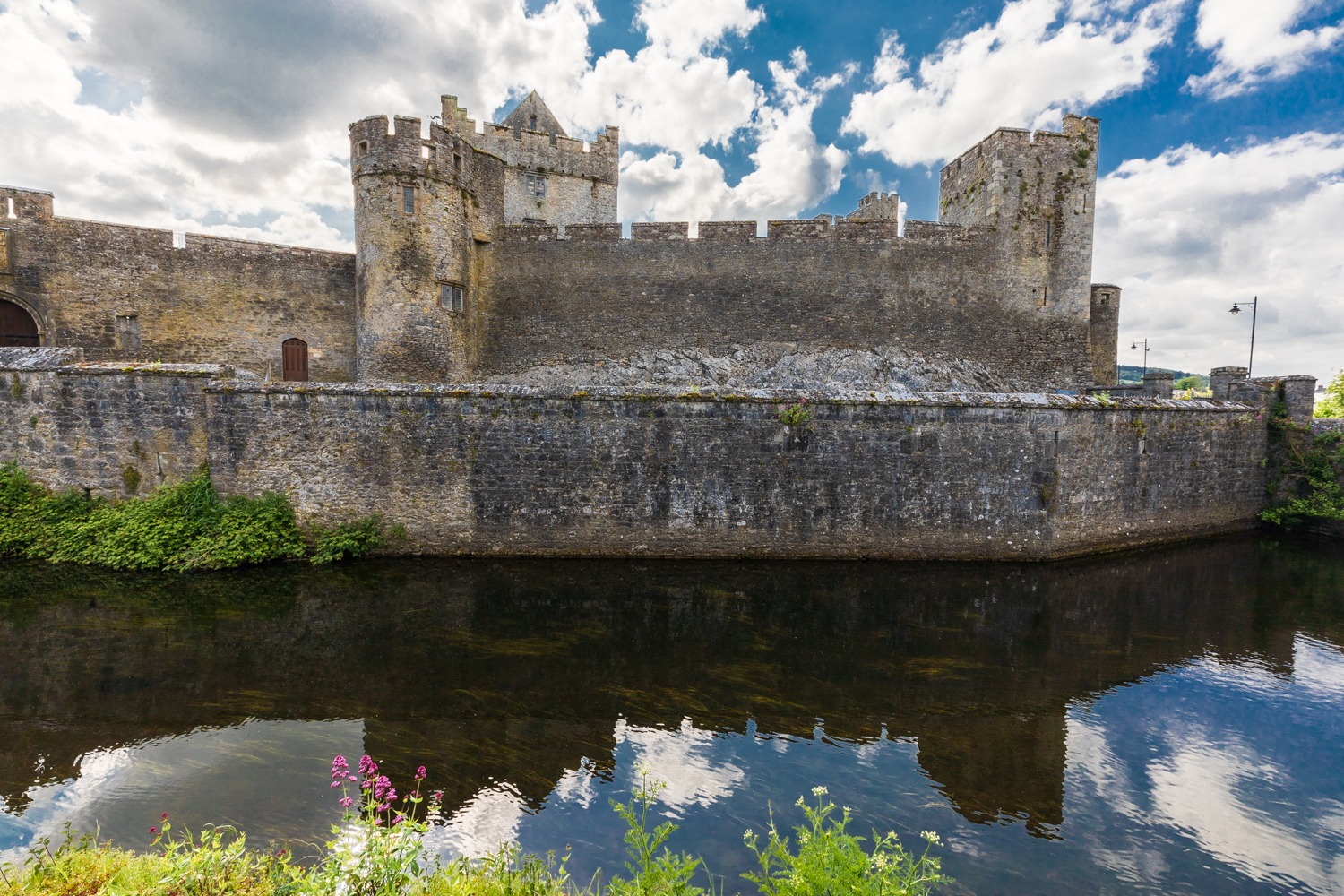


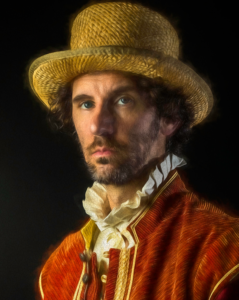

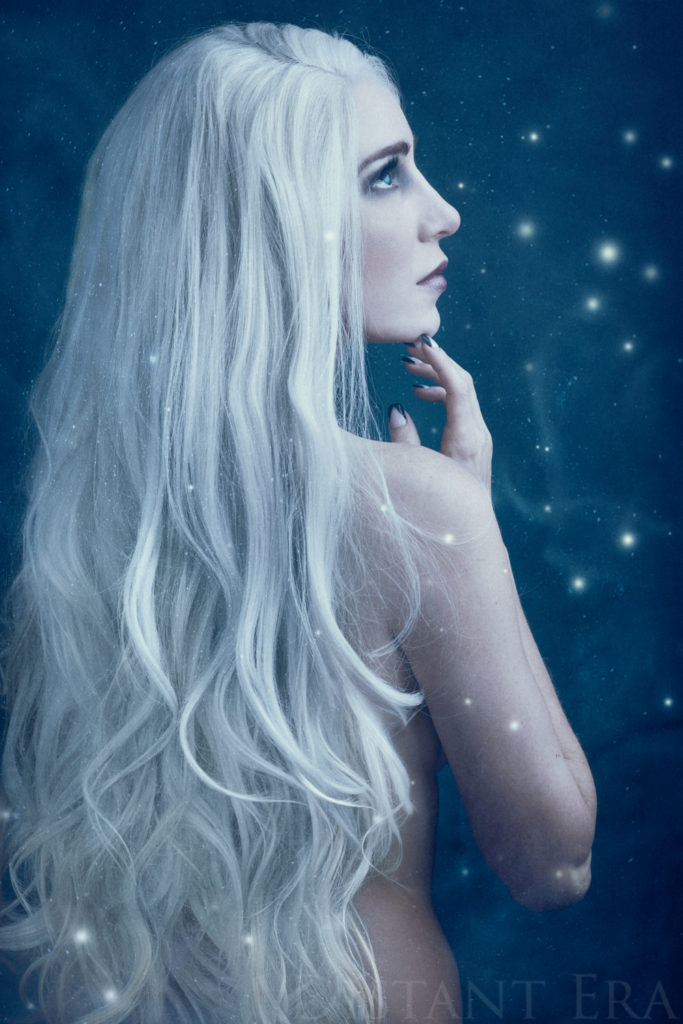
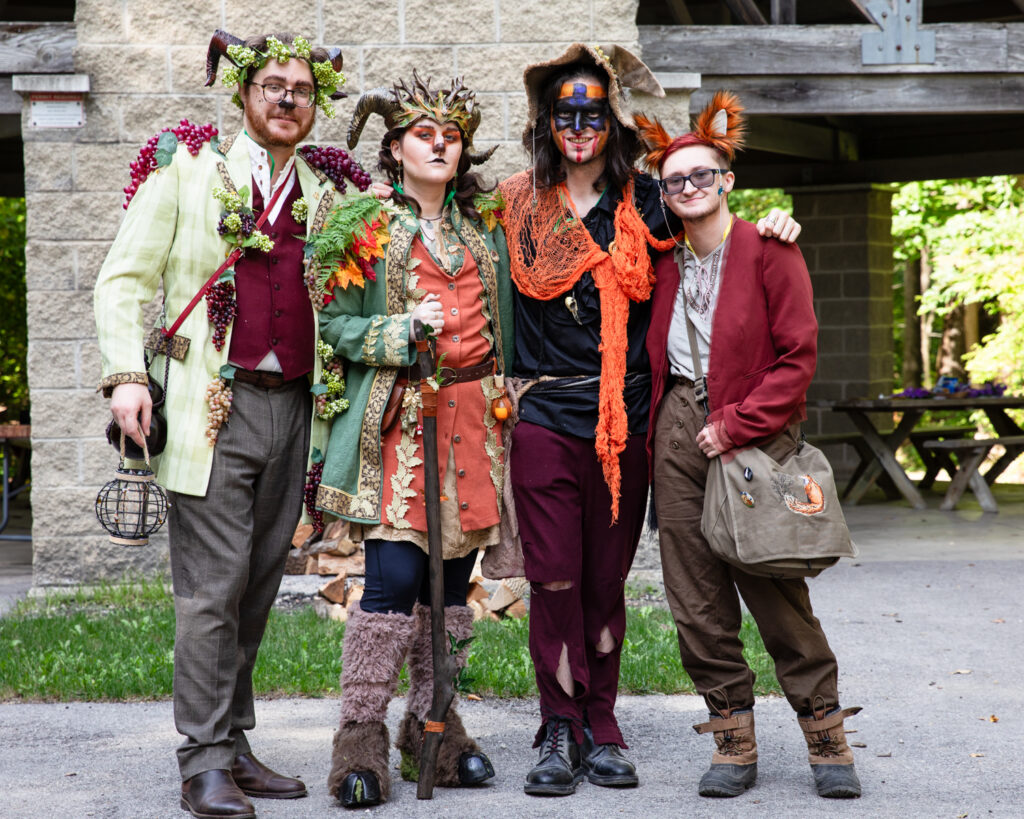
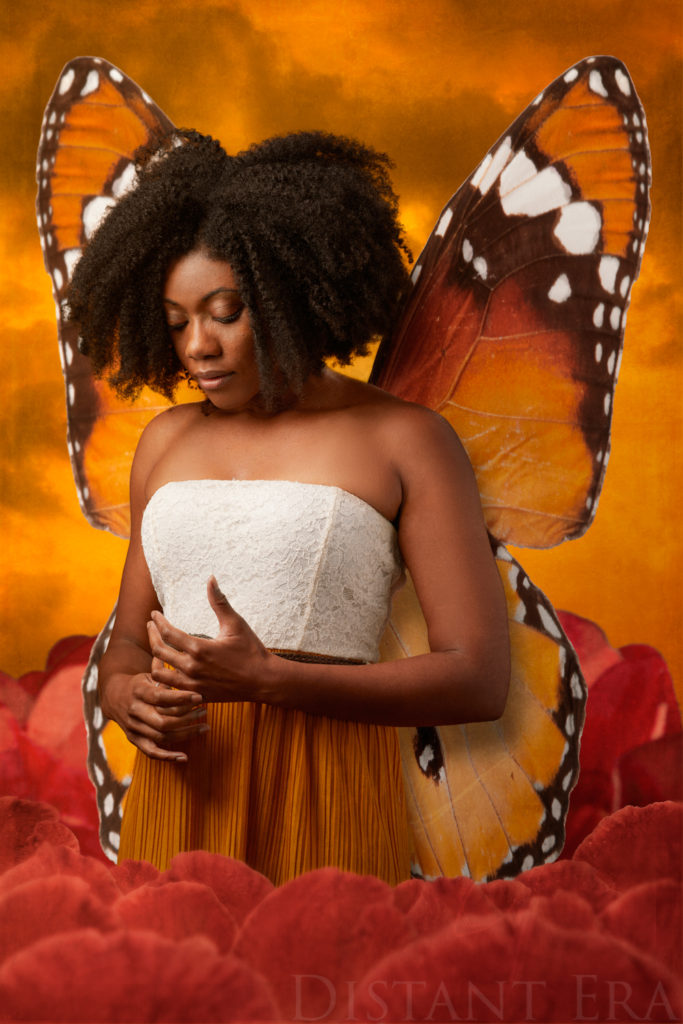
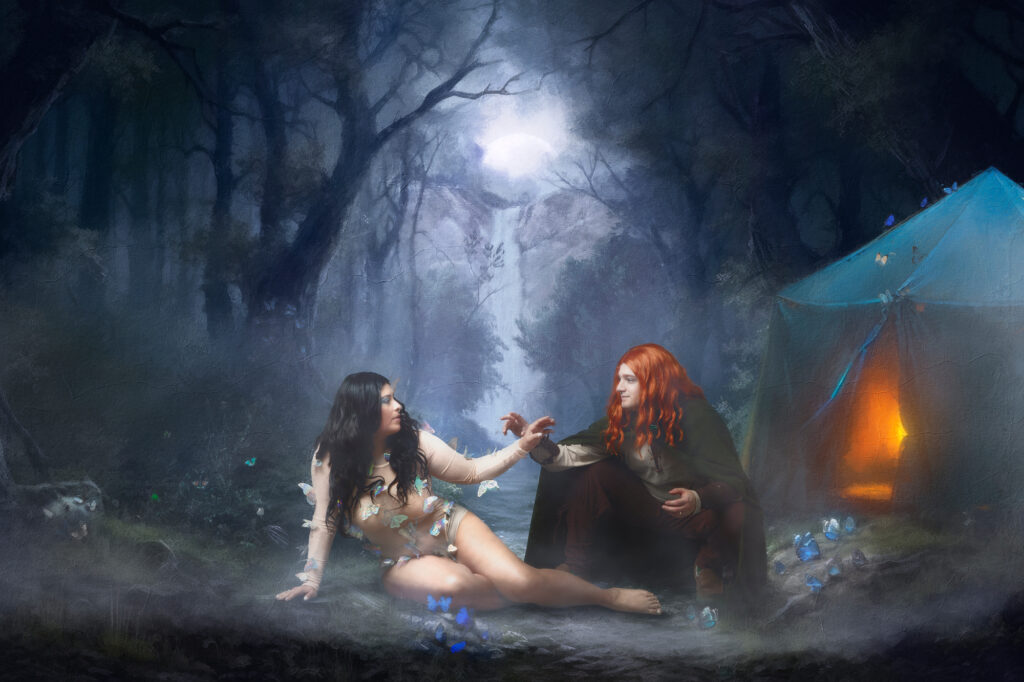
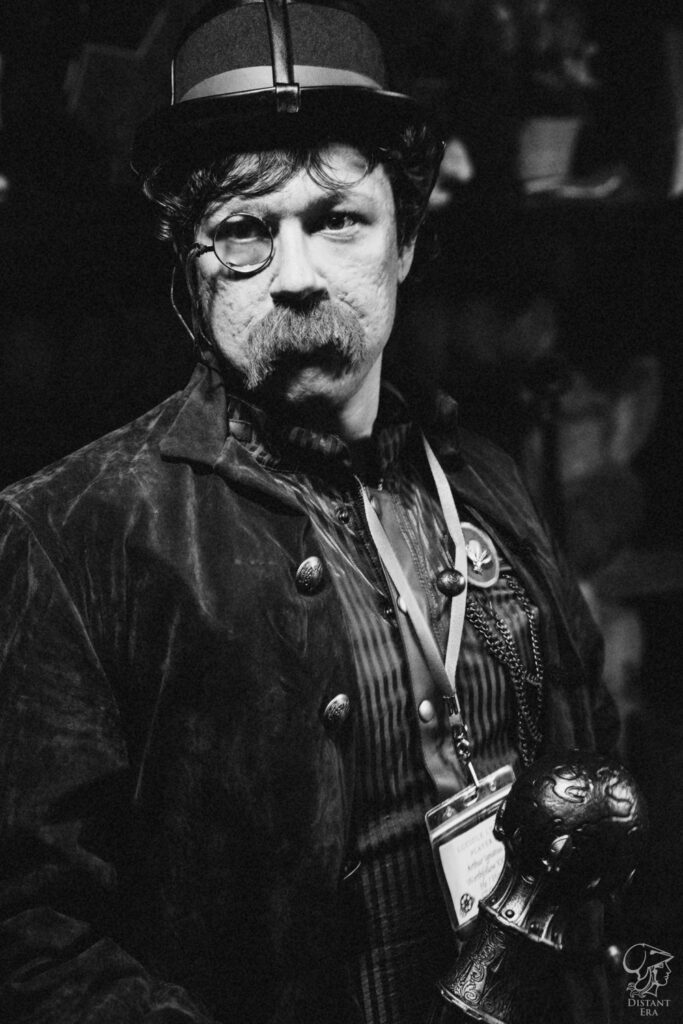
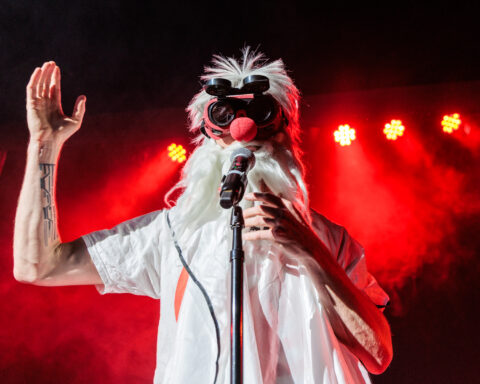
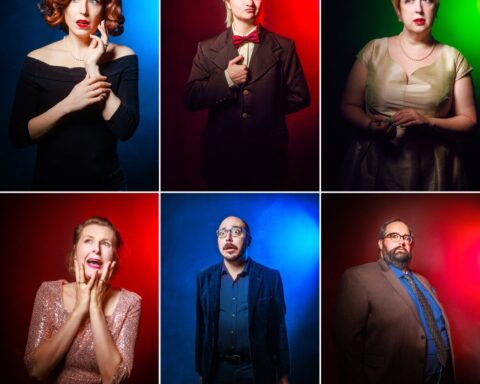
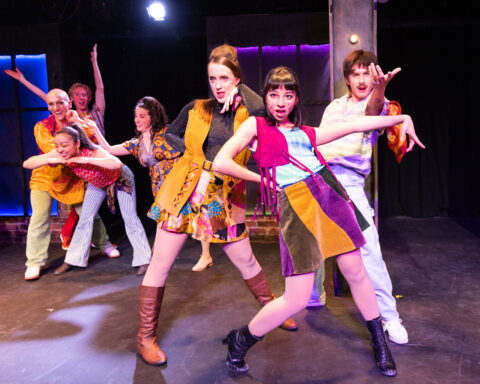


Follow Me